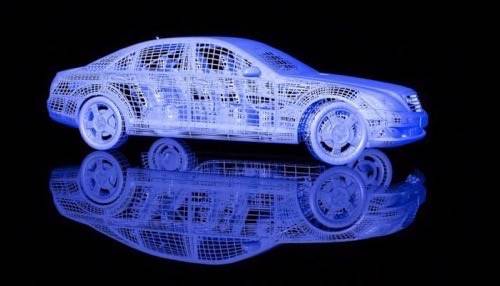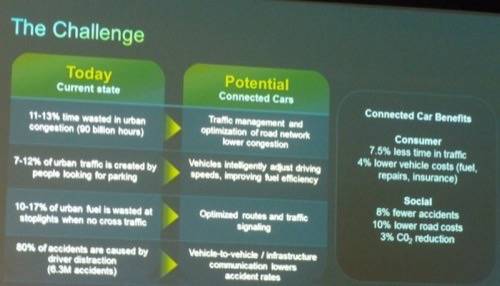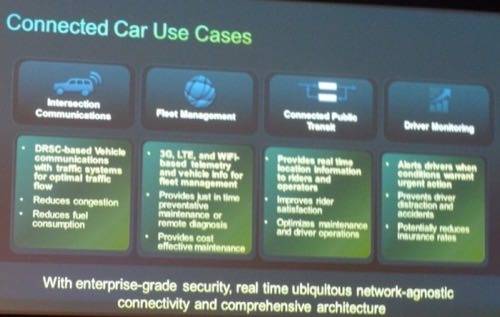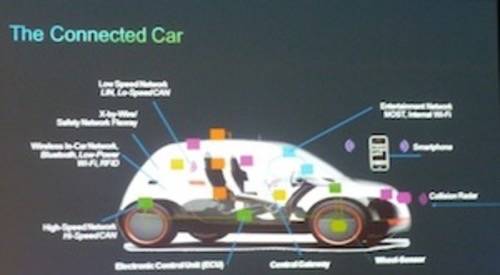
Connected cars are hotter than turbo-charged V6 running at 8,000 RPM. The hype about how they’re going to change the driving and passenger experience is accelerating faster than Danica Patrick coming out of a turn at a NASCAR race.
But most of the promises I’ve heard so far center around relatively prosaic things like better entertainment systems and integrated navigation. I like a great car stereo as much as anyone, but that just doesn’t seem particularly revolutionary to me.
(See also Cars & The Internet Get Together At SXSW)
So I was looking forward to the connected car presentation at the Cisco Editors Conference in San Jose, Calif., on Wednesday. Much of it turned out to be pretty technical, all about how Cisco plans to support the back end of the process. That’s important, but I was more interested in the some of the passing comments on the actual benefits connected cars are likely to deliver.

Why Driving Stinks
Maciej Kranz, VP and GM of Cisco’s Connected Industries Group, laid out some of the grim statistics plaguing the world yet-to-be-connected cars:
Between 11% and 13% of commuting time is wasted in urban traffic congestion, for a total of 90 billion hours. (It just seems like of half of that is on the 101 Freeway between San Francisco and San Jose.) Some 7% to 12% of urban congestion is caused by people looking for parking. (It just seems like all of that comes in San Francisco’s North Beach neighborhood.) Between 10% and 17% of of urban fuel is wasted at stoplights when there is no crosstraffic. Eighty percent of accidents (6.3 million) are caused by driver distraction.
“The good news,” Kranz said, “is that we can actually lower all of these numbers quite dramatically.”

How Connected Cars Make Driving Better
For congestion, that means traffic management and optimization of road networks. For parking issues, connected cars can link apps identifying the closest, most affordable available parking spaces to the vehicle’s navigation. And the vehicles can intelligently adjust driving speeds to boost fuel efficiency.
Intelligent stoplights, for example, would know if there were 10 cars waiting in one direction but only 1 in the other, and adjust light timing to keep traffic moving. Along straight routes, Kranz said, they can build “green waves” of traffic signals to keep lanes flowing efficiently.
There’s also the idea that if one car knows what other vehicles. traffic lights and other road infrastructure are doing, they can all adjust more efficiently. For examply, if your car knows that the car in front is about to make a turn or start braking, it can begin reacting even before it actually senses the action.
Cisco estimates this could lead to 7.5% less time wasted in traffic congestion and 4% lower costs for vehicle fuel, repairs and insurance. The benefits are particularly obvious in fleet settings, Kranz said. For example, a company with 10,000 delivery trucks would find it very valuable to be able to use connected technology to schedule preventive maintenance.
As for preventing accidents, vehicle-to-vehicle communications could enable a connected car to alert you if you get too close to the vehicle in front of you. If you don’t respond, Kranz said, “at some point the car will make a decision to hit the brakes and avoid the accident.”
Cisco estimatd 8% fewer accidents, 10% lower road costs and a 3% drop in carbon dioxide emissions.

Not Just Connecting The Car, But Also All Its Parts
The key to making all this happen, Kranz said, is not just connecting the car to the Internet, but also connecting together all of the various siloed subsystems in the car. When you connect a car to the Net, he said, “good things happen. More good things happen when you connect all of the systems,” including telematics, diagnostics and driver assistance systems. Looked at this way, a self-driving car is just an advanced application of a connected car, taking over a higher-than usual proportion of the required tasks.
Cisco is pushing DSRC (Dedicated Short-Range Communications) technology to tie together the vehicle’s various systems with the wider Internet.
Heck, if you ask me, though, even if connected cars just help me find a parking space on a Saturday night, all the development effort is totally worth it.
Lead image courtesy of Shutterstock.










